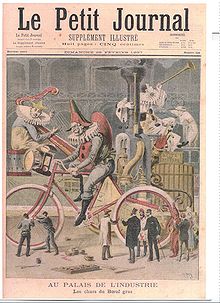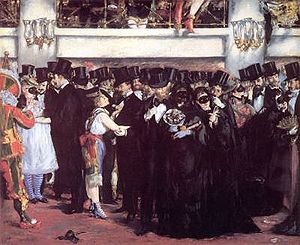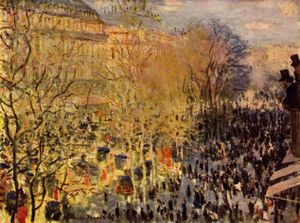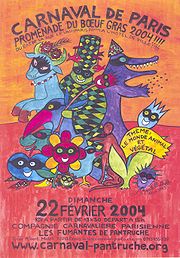
Paris Carnival
Encyclopedia

Carnival
Carnaval is a festive season which occurs immediately before Lent; the main events are usually during February. Carnaval typically involves a public celebration or parade combining some elements of a circus, mask and public street party...
in the city of Paris
Paris
Paris is the capital and largest city in France, situated on the river Seine, in northern France, at the heart of the Île-de-France region...
in France
France
The French Republic , The French Republic , The French Republic , (commonly known as France , is a unitary semi-presidential republic in Western Europe with several overseas territories and islands located on other continents and in the Indian, Pacific, and Atlantic oceans. Metropolitan France...
. It occurs after the Feast of Fools
Feast of Fools
The Feast of Fools, known also as the festum fatuorum, festum stultorum, festum hypodiaconorum, or fête des fous, are the varying names given to popular medieval festivals regularly celebrated by the clergy and laity from the fifth century until the sixteenth century in several countries of Europe,...
and has been held since the sixteenth century or earlier, with a long 20th century interregnum.
History of Carnival in Paris
The Carnival of Paris is a festival with a very long history in the French capital. Nicolas de Baye wrote in his journal in 1411:"Monday, the 22nd of February, the royal household, in order to observe the Lenten feast, which is tomorrow, will be rising before dawn [to prepare]".
The staying-power of the Carnival of Paris, the elements that have made it an institution for centuries, is based on an unbroken tradition of "festive and carnival societies" (the equivalent of the samba school
Samba school
A samba school is a club or dancing school. They practice and often perform in huge square-compounds devoted to practicing and exhibiting samba, an African-Brazilian dance. The schools are traditionally associated with a particular neighborhood, often shanty towns...
s in Rio de Janeiro or the krewe
Krewe
A krewe is an organization that puts on a parade and or a ball for the Carnival season. The term is best known for its association with New Orleans Mardi Gras, but is also used in other Carnival celebrations around the Gulf of Mexico, such as the Gasparilla Pirate Festival in Tampa, Florida, and...
s of the New Orleans Mardi Gras
Mardi Gras
The terms "Mardi Gras" , "Mardi Gras season", and "Carnival season", in English, refer to events of the Carnival celebrations, beginning on or after Epiphany and culminating on the day before Ash Wednesday...
) and the organized involvement of certain civic groups, corporations, and trade unions. The central role of the working class is illustrated, for example, by an anonymous poem of the eighteenth century:
Always at these kinds of masquerades,
Workers take their special pleasures.
They wail, "We must watch our parades!
This is something we've all treasured!"
Tomorrow we'll return to the usual grind,
When Mardi Gras is, sadly, over,
Food and drink will be hard to find
And we'll do our best to recover.
Workers have always played a central role in the celebrations. What is less known is the fact that the Carnaval de Paris is also, traditionally, the feast of the Paris police. During the nineteenth century, the involvement of butchers, launderers, traders, and students became essential to the liveliness of the Carnival. The variety, the multi-class composition, of the participants is found in carnivals throughout the world. Whether in Dunkirk or Brazil, tradition, organization, and the involvement of diverse segments of the population are essential for the well-being of the party.

Antoine Furetière
Antoine Furetière , French scholar and writer, was born in Paris.-Biography:He studied law and practised for a time as an advocate, but eventually took orders and after various promotions became abbé of Chalivoy in the diocese of Bourges in 1662...
wrote these words, which apply also to Paris:
"CARNIVAL, masculine noun: time of rejoicing lasting from Epiphany until Lent. Dances, feasts, and marriages are mainly held at Carnival time."
Sixty-two years later, in 1752, the Encyclopedia
Encyclopedia
An encyclopedia is a type of reference work, a compendium holding a summary of information from either all branches of knowledge or a particular branch of knowledge....
of Denis Diderot
Denis Diderot
Denis Diderot was a French philosopher, art critic, and writer. He was a prominent person during the Enlightenment and is best known for serving as co-founder and chief editor of and contributor to the Encyclopédie....
and Jean le Rond d'Alembert
Jean le Rond d'Alembert
Jean-Baptiste le Rond d'Alembert was a French mathematician, mechanician, physicist, philosopher, and music theorist. He was also co-editor with Denis Diderot of the Encyclopédie...
confirmed this impression with almost the same words Furetière used. (In fact, so close is the correspondence that, it seems, Furetière might have been Diderot’s source.):
"The carnival begins the day after Epiphany, or the 7th of January, and lasts until Lent. Dances, feasts, and marriages are mainly held during carnival."
However, the Carnaval de Paris has also endured a hiatus; it was interrupted between 1952 and 1997. Even today, many Parisians do not know that the carnival exists. They are also ignorant of the fact that central to the carnival celebration is the appearance of certain traditional characters, stereotypes with distinctive costumes who appear every year, and that there are a number of traditional carnival jokes. These truly "old jokes" have survived from as long ago as the seventeenth century. During the hiatus the words "Carnaval de Paris" were seldom spoken. Parisians were always able to celebrate "Mardi Gras", of course; they simply had to travel to Nice
Nice
Nice is the fifth most populous city in France, after Paris, Marseille, Lyon and Toulouse, with a population of 348,721 within its administrative limits on a land area of . The urban area of Nice extends beyond the administrative city limits with a population of more than 955,000 on an area of...
or Rio de Janeiro
Rio de Janeiro
Rio de Janeiro , commonly referred to simply as Rio, is the capital city of the State of Rio de Janeiro, the second largest city of Brazil, and the third largest metropolitan area and agglomeration in South America, boasting approximately 6.3 million people within the city proper, making it the 6th...
.

Street activities
At street level, two types of event are traditionally part of the Carnival de Paris: the walk of masks, and the processions.The walk of masks involves people in disguise in huge numbers, and the curious come to see them, at a given location at a given time. Here's what Dulaure says of this phenomenon in 1787 :
"Rue Saint-Antoine is famous for the prodigious contest of masks held every year on the last day of the carnival, which attracts a large number of the curious."

- The fat days occurred during "the last days of carnival", according to Dulaure. The "fat days" started during the eighteenth century, when they began on Thursday and ended five days later, on Mardi Gras. In the nineteenth century, they were restricted to Sunday, Monday, and Mardi Gras (Tuesday) only. They end when the Promenade du Boeuf Gras (Procession of the Fat Ox) begins.
- Twenty-one days after Mardi Gras is the Thursday of Mid-Lent (Mi-Carême). Mid-Lent is also called the Feast of Laundresses, for it is the feast day of their parade, and of their queens, and of the Queen of Laundresses. They inspired, during the last years of the nineteenth century, other guilds and unions to elect their own queens. Also known as the ‘’Vachalcade’’. Originally intended to be an annual event, it only lasted two seasons.
Modern day carnival
In 1997 the carnival was restarted by the Les Fumantes de Pantruches and Droit à la Culture groups. They are still quite active and hold several events each year - Carnaval de Paris and the Carnaval des Femmes de Paris., of which the poster on this page is an example. Their 2011 event is now in the planning stages.Since 2002 a Carnaval has also been run by MACAQ - the Movement for the Cultural and Artistic Liveliness of the Quarter. There were around 1500 participants in 2007, with 10,000 spectators, which grew to 15,000 participants and 40,000 spectators in 2009, according to the organizers. In 2010 the carnival coincided with Valentine's Day
Valentine's Day
Saint Valentine's Day, commonly shortened to Valentine's Day, is an annual commemoration held on February 14 celebrating love and affection between intimate companions. The day is named after one or more early Christian martyrs named Saint Valentine, and was established by Pope Gelasius I in 496...
and Chinese New Year
Chinese New Year
Chinese New Year – often called Chinese Lunar New Year although it actually is lunisolar – is the most important of the traditional Chinese holidays. It is an all East and South-East-Asia celebration...
, the theme was improbable couples. It set off from Place Gambetta and went via Belleville, where it met the Chinese New Year
Chinese New Year
Chinese New Year – often called Chinese Lunar New Year although it actually is lunisolar – is the most important of the traditional Chinese holidays. It is an all East and South-East-Asia celebration...
parade, to République, before arriving at Hôtel de Ville
Hôtel de Ville, Paris
The Hôtel de Ville |City Hall]]) in :Paris, France, is the building housing the City of Paris's administration. Standing on the place de l'Hôtel de Ville in the city's IVe arrondissement, it has been the location of the municipality of Paris since 1357...
.
External links
- Carnaval de Paris (Droit à la Culture)
- Carnaval de Paris
- Radio France Internationale - Unlikely couples in Paris on Valentine's Day, RadioRadioRadio is the transmission of signals through free space by modulation of electromagnetic waves with frequencies below those of visible light. Electromagnetic radiation travels by means of oscillating electromagnetic fields that pass through the air and the vacuum of space...
report and slideshowSlideshowA slide show is a display of a series of chosen information or pictures, done for artistic or instructional purposes. Slide shows are conducted by a presenter using an apparatus, such as a carousel slide projector, an overhead projector or in more recent years, a computer running presentation...
from ParisParisParis is the capital and largest city in France, situated on the river Seine, in northern France, at the heart of the Île-de-France region...
carnivalCarnivalCarnaval is a festive season which occurs immediately before Lent; the main events are usually during February. Carnaval typically involves a public celebration or parade combining some elements of a circus, mask and public street party...

